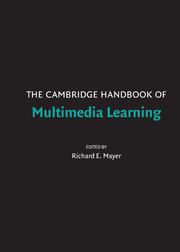Book contents
- Frontmatter
- Contents
- Preface
- Contributors
- 1 Introduction to Multimedia Learning
- PART I THEORETICAL FOUNDATIONS
- PART II BASIC PRINCIPLES OF MULTIMEDIA LEARNING
- 6 Five Common but Questionable Principles of Multimedia Learning
- 7 The Multimedia Principle
- 8 The Split-Attention Principle in Multimedia Learning
- 9 The Modality Principle in Multimedia Learning
- 10 The Redundancy Principle in Multimedia Learning
- 11 Principles for Managing Essential Processing in Multimedia Learning : Segmenting, Pretraining, and Modality Principles
- 12 Principles for Reducing Extraneous Processing in Multimedia Learning : Coherence, Signaling, Redundancy, Spatial Contiguity, and Temporal Contiguity Principles
- 13 Principles of Multimedia Learning Based on Social Cues : Personalization, Voice, and Image Principles
- PART III ADVANCED PRINCIPLES OF MULTIMEDIA LEARNING
- PART IV MULTIMEDIA LEARNING IN CONTENT AREAS
- PART V MULTIMEDIA LEARNING IN ADVANCED COMPUTER-BASED CONTEXTS
- Author Index
- Subject Index
- References
13 - Principles of Multimedia Learning Based on Social Cues : Personalization, Voice, and Image Principles
Published online by Cambridge University Press: 05 June 2012
- Frontmatter
- Contents
- Preface
- Contributors
- 1 Introduction to Multimedia Learning
- PART I THEORETICAL FOUNDATIONS
- PART II BASIC PRINCIPLES OF MULTIMEDIA LEARNING
- 6 Five Common but Questionable Principles of Multimedia Learning
- 7 The Multimedia Principle
- 8 The Split-Attention Principle in Multimedia Learning
- 9 The Modality Principle in Multimedia Learning
- 10 The Redundancy Principle in Multimedia Learning
- 11 Principles for Managing Essential Processing in Multimedia Learning : Segmenting, Pretraining, and Modality Principles
- 12 Principles for Reducing Extraneous Processing in Multimedia Learning : Coherence, Signaling, Redundancy, Spatial Contiguity, and Temporal Contiguity Principles
- 13 Principles of Multimedia Learning Based on Social Cues : Personalization, Voice, and Image Principles
- PART III ADVANCED PRINCIPLES OF MULTIMEDIA LEARNING
- PART IV MULTIMEDIA LEARNING IN CONTENT AREAS
- PART V MULTIMEDIA LEARNING IN ADVANCED COMPUTER-BASED CONTEXTS
- Author Index
- Subject Index
- References
Summary
Abstract
Social cues may prime social responses in learners that lead to deeper cognitive processing during learning and hence better test performance. The personalization principle is that people learn more deeply when the words in a multimedia presentation are in conversational style rather than formal style. This principle was supported in 10 out of 10 experimental tests, yielding a median effect size of 1.3. The voice principle is that people learn more deeply when the words in a multimedia message are spoken in a standard-accented human voice rather than in a machine voice or foreign-accented human voice. This principle was supported in four out of four experimental comparisons, with a median effect size of 0.8. The image principle is that people do not necessarily learn more deeply from a multimedia presentation when the speaker's image is on the screen rather than not on the screen. This principle was based on nine experimental tests with mixed results, yielding a median effect size of 0.2.
What Are the Personalization, Voice, and Image Principles?
Definitions
The goal of this chapter is to examine the research evidence concerning three principles for multimedia design that are based on social cues – personalization, voice, and image principles. The personalization principle is that people learn more deeply when the words in a multimedia presentation are in conversational style rather than formal style.
- Type
- Chapter
- Information
- The Cambridge Handbook of Multimedia Learning , pp. 201 - 212Publisher: Cambridge University PressPrint publication year: 2005
References
- 87
- Cited by

